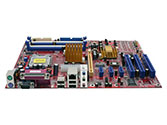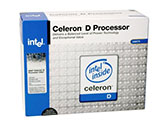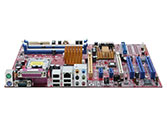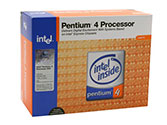Entry Level Buyer’s Guide, July 2005
by Jarred Walton on July 20, 2005 12:05 AM EST- Posted in
- Guides
Intel Recommendations
Not a whole lot has changed in the budget Intel market. Intel has had PCIe graphics for a while now, and we're still waiting for newer Celeron and Pentium chips with 64-bit support. (We're also waiting for Semprons with 64-bit support, though really we're not too concerned about the 64-bit factor for budget systems.)  |
 |
| Click images to enlarge. | |
Budget 775 Motherboard: Biostar I915P-A7
Price: $79 shipped
Budget 775 CPU: Intel Celeron D 330J 2.66GHz 256K L2 (Retail)
Price: $85 shipped (Retail)
Total: $164
Almost exactly matching the budget AMD setup in price, we continue with similar recommendations to our last budget Guide. The choice of CPU is less about performance than price, but the difference between the 2.53 GHz 325 and the 2.66 GHz 330J is only $4, so we go with the upgraded processor. You can see the complete list of Celeron prices on our Price Engine, and the next model up from the 330J adds $15, which is more than we're willing to pay for a budget setup.
The motherboard choice is the cheapest 775 motherboard that we could find with a few qualifications. First, it needs to be a PCI Express board, which generally means the 915P or 915G chipset. We avoid the 915GV chipset as that reduces performance by only supporting single-channel memory. The other requirement is that the board needs to have 4 DIMM slots of the same type, and for now, that means DDR. Some people may not mind the hybrid boards, but we like to have the ability to run 4x512MB of RAM in the future. The Biostar I915P-A7 fits all of those requirements and comes in substantially cheaper than most other competitors. Biostar also offers the I915G-M7 for those who want integrated graphics - as a business solution or a standby until you can add in a decent graphics card, the extra $6 is a good deal.
The only other boards that are priced similarly are from Jetway (915PCP/GCP), ECS (915G-M), Foxconn (915G7MC-S), and Aopen (i915Pa-E) - we may have missed one or two boards, but the point is that there aren't any name brands like ASUS or MSI in this price range. None of these are really better than the Biostar in our opinion, and they all cost a bit more.
If you like the idea of integrated graphics but want more performance, the ASUS P5RD1-V uses the ATI Xpress 200 chipset and may be worth consideration. The price of $100 makes it a moderately expensive upgrade, and if you're looking at an IGP solution you probably don't care much that the Xpress 200 is twice as fast in several gaming benchmarks - a discrete graphics card will still outperform the IGP with relative ease. As with the MSI Xpress 200 board for AMD, we don't expect much in the way of overclocking due to the chipset. Overclockers should probably look to the more recognized enthusiast brands like ASUS, DFI, MSI, etc. and get an Intel chipset, though you'll also have to pay over $100 for those.
 |
 |
| Click images to enlarge. | |
Upgraded 775 Motherboard: Biostar I945P-A7
Price: $98 shipped
Upgraded 775 CPU: Intel Pentium 505 533 FSB (Retail)
Price: $134 shipped (Retail)
Total: $232
Our upgraded Intel platform takes a bit different approach than the past. Price is once again equal to the AMD side of things, but we spend more on the motherboard and less on the CPU. We cut the CPU from the Pentium 520 of previous Guides (2.8 GHz 800FSB with HyperThreading) to the 505 (2.66 GHz 533FSB and no HyperThreading). HTT is sort of interesting, but the extra $40 to upgrade to the 520 is pretty significant. Actually, the 530J is only a couple of dollars more than the 520, so if you do go for the faster processor, the 530J is the better buy. Performance of the 505 is reasonable, though clearly outclassed by the Athlon 64 processors. Part of the reason why we like the 505 is that you can get some great overclocking results from it on virtually any motherboard. The processor has a 20X multiplier, so combined with a bus speed of 166 to 200, you can shoot for 3.33 GHz to 4.0 GHz. The upper end of that range may be difficult to reach, but 3.4 to 3.6 GHz is pretty reasonable for the 90nm Prescott design.
Along with the switch to a slightly slower CPU, we've included the cheapest DDR2 board that we could find for future compatibility, and it also uses the new 945P chipset. The switch to DDR2 will increase the price slightly relative to DDR, but even AMD will be moving to DDR2 early next year, so you should be able to use the RAM in a future system. Integrated graphics versions of the chipset are also available with the 945G series, with the most affordable options coming from ASUS (P5LD2-VM) and Intel themselves. The cheapest 945G models are micro ATX form factors, allowing the use of a smaller case like the Aspire X- QPack that we recently reviewed, as well as any other uATX case. (You can always put the small motherboard in a full-size ATX case if you prefer.)
The 945 chipsets all support dual core CPUs, providing another future upgrade path. With the cheapest Pentium D starting at well over $200, we can't recommend such a CPU for a budget system yet, but we expect prices to drop over the coming year, making it a viable upgrade in 2006. If you go with the budget Intel recommendation, you're stuck with single core processor support for as long as you own the system. Of course, some people never upgrade individual components and prefer to replace the entire system every few years. If that describes your purchasing habits, there's not much point in buying more future-proof components.










57 Comments
View All Comments
RussellCollins - Wednesday, August 31, 2005 - link
So let's just start with some basics. I have relied upon the reviews here for the last 6 or 7 years when it came to building computers. I have built several of my own based upon a mix of recommendations from this site and personal research. My background is in mechanical engineering and I am currently working as a software test engineer. I say that to suggest that even those who know better can pay for their mistakes they shouldn't have made...I built a system for my parents (*gasp, that's already asking for trouble) based almost exclusively off this entry-level model (AMD flavor). It worked perfectly for about a week and then the system simply refused to turn on. I tried checking as many things as I could to narrow down the problem based on the limited equipment I had on hand. I thought at first that a bad power-supply might have fried some of the silicon so I had them get a new mobo after all the components plugged into it (save for the CPU) were tested on other machines and appeared to be fine.
Needless to say, I'm STILL ironing out the kinks in my spare time because it refuses to breath again. The fans all turn on but nobody's home (won't even post to BIOS). I'll be installing a new CoolerMaster PSU and probably new CPU this week just to finally resolve the issue.
Final words: go with your instinct for self-preservation and get a trustworthy power supply. It isn't worth the risk and headache. This was a good review overall but I wish now that I had gone with my first hunch to swap out power supplies before the first boot.
DarkForceRising - Sunday, August 28, 2005 - link
Does the Foxconn AMD Mobo. have integrated graphics?Gioron - Sunday, July 24, 2005 - link
Ok, I hate to harp on it, but I'm going to anyways. The included power supply in the case is a bad idea. Although I can't be sure this is the exact power supply, I went and found a review of a 350W codegen from annother cheap case. Here's the picture of the spec sheet: http://www.mikhailtech.com/articles/psu/codegen350...">http://www.mikhailtech.com/articles/psu/codegen350...Things of note:
How the hell does that add up to 350W? I only get about 330W just by adding everything together. It sure as heck can't output all of that at once, and usually its a good idea to ignore the piddly little negatives and the VSB buss, which would drop it down to a heck of a lot lower than 300W. Honestly, I'd be suprised if this can handle 200W well. The only real hope is that they've improved their 350W power supplies in the couple years since the review, but I would doubt it.
And then there's the quote from the article: "Worst case scenario - pardon the pun - is that you'll have to purchase a new power supply down the road (and/or deal with RMA issues)."
No, thats _NOT_ the worst case scenario, although its a likely scenario. I had to completely replace every component in my parent's computer when their power supply died. I tested everything seperately and every single component in the system was toast. And the real worst case scenario involves an electical fire burning your house down (yah yah, not terribly likely, but a lot more likely with that power supply than with a quality one). Power supply death isn't something you want to deal with.
As far as dell systems go, it was interesting to note that 2 of them on the site ended up dying when we had a planned power outage, even though the computers were switched off at the time. The sun boxes we also use came through fine.
Side note: I was viewing the comments, then had to reload the dang thing because of an error. Then <poof>, the new comment system was in. Somewhat confusing to get used to, not sure I like the change yet, but just barely using it. Might be a good idea to add post numbers to things like this, just since everyone is so used to saying "#12, you're an idiot", etc. And add a preview button while you're at it.
Pythias - Monday, September 5, 2005 - link
Is this budget system going to pull 330 watts at peak?spartacvs - Monday, July 25, 2005 - link
I totally agree with you. It's funny because the computer case is propably the least important part of a computer. But the power supply is probably the most important. lolI don't think the problem is comming from Jarred. IMO, he do a hell of a good job in his systems guides. No, imo, the problem might coming from the price limit. Maybe 500$ is too low, maybe go with 550-600$. Sure you can buy a system for that price but is it really viable? Will you end up with a much better system that will last longer (eg. the messages about the monitor) for 50-100$ more?
JarredWalton - Tuesday, August 2, 2005 - link
Thanks, spartacvs...The budget price is killer. I deal with people asking about $500 PCs all the time, and I shudder at the compromises that often need to be made. You're right about the PSU, Gioron: the WORST that can happen is really bad. Very unlikely IMO, but I have had a cheap PSU fry everything in a system (other than the graphics, sound, HDD, and CD-ROM). That was an old socket 370 board, and the Celeron, motherboard, and RAM all got toasted along with the PSU.
For what it's worth, I really do encourage people to upgrade the PSU. Still, I *think* these chepaer cases will do okay with budget components. Don't upgrade the graphics or CPU and stick with a single HDD and you should do okay. I think I may actually go out and purchase one of these cases for an article. A sort of PSU expose to see if I can get better OC results and stability with a good PSU rather than the crappy "350W" included. Heheheh.... stay tuned! :D
spartacvs - Thursday, July 21, 2005 - link
And you can still buy a video board later. Also, a monitor last longer (like most of the peripherals).Zebo - Thursday, July 21, 2005 - link
True I hear ya. But the low end LCD's dont usually have DVI... All I'm saying is if I had $500 for a system I'd rather have integrated graphics and a 17" LCD than a 6200 TC with a 17" cheap CRT. As ones budget gets higher more and better options open up.. maybe I'm just low-balling to much.:)OldPueblo - Thursday, July 21, 2005 - link
The 6200TC allows you to play BF2, D3, HL2, and whatever else for an amazingly low price. The card is a gift in my eyes. I have friends that just absolutely cannot afford anything else, and to them its a godsend.JarredWalton - Thursday, July 21, 2005 - link
44 - Calin, I'm not a big fan of mail-in rebates, so you're looking at $280 for the cheapest 19" LCD that has DVI input. If you don't mind MIRs, you can get an Aopen F90JS for $242 from Newegg - $70 MIR. I still say the Acer AL1914SMD at $307 is a great LCD, though. Expensive for a "budget" system, but a good display can last through 3 computer upgrades or more.43 - Zebo, I'd like to recommend an LCD with integrated graphics, but the lack of DVI output from the IGP motherboards makes the add-in card almost a requirement in my book. (That's another one of the problems I have with the "free LCD upgrades" you get from OEMs; LCDs without DVI are simply not the same.) It's still an option, though, and I think the recommendations in this Guide give people enough information to put together such a setup if they want.